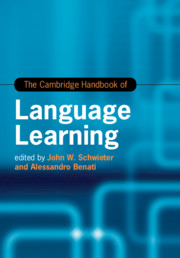Book contents
- The Cambridge Handbook of Language Learning
- Cambridge Handbooks in Language and Linguistics
- The Cambridge Handbook of Language Learning
- Copyright page
- Contents
- Figures
- Tables
- Contributors
- Acknowledgements
- Introduction
- Part I Theories
- Part II Methods
- Part III Skill Development
- Part IV Individual Differences
- Part V Pedagogical Interventions and Approaches
- Part VI Context and Environment
- 27 Bilingual Education and Policy
- 28 Heritage Language Instruction
- 29 Minority Languages at Home and Abroad: Education and Acculturation
- 30 Study Abroad and Immersion
- 31 Teacher Education: Past, Present, and Future
- Part VII Moving Forward
- Index
- References
29 - Minority Languages at Home and Abroad: Education and Acculturation
from Part VI - Context and Environment
Published online by Cambridge University Press: 25 June 2019
- The Cambridge Handbook of Language Learning
- Cambridge Handbooks in Language and Linguistics
- The Cambridge Handbook of Language Learning
- Copyright page
- Contents
- Figures
- Tables
- Contributors
- Acknowledgements
- Introduction
- Part I Theories
- Part II Methods
- Part III Skill Development
- Part IV Individual Differences
- Part V Pedagogical Interventions and Approaches
- Part VI Context and Environment
- 27 Bilingual Education and Policy
- 28 Heritage Language Instruction
- 29 Minority Languages at Home and Abroad: Education and Acculturation
- 30 Study Abroad and Immersion
- 31 Teacher Education: Past, Present, and Future
- Part VII Moving Forward
- Index
- References
Summary
Nearly all societies are bilingual (Appel & Muysken, 2006), a fact which places monolingualism in the minority. Multilingual individuals who live within the same national borders use the official language of the country in addition to their own to survive socially and economically. Globally, the position of English as a lingua franca has compelled people to learn it (Ur, 2010), which might suggest that in most cases, bilingualism is really understood as proficiency in English plus another language. In immigration contexts, families have to learn the dominant language—normally the most prestigious language—to be integrated to the new community, usually suppressing their minority language. According to Ferreira et al. (2016), the learners’ attitude towards the more prestigious linguistic group might have a positive impact on learning the new language, but maintaining the heritage language and culture seems to be an arduous task, even though the maintenance of heritage culture has benefits for first language (L1) literacy skills in addition to cognitive-linguistic variables, favouring a bi-dimensional model of acculturation (Berry, 1990).
- Type
- Chapter
- Information
- The Cambridge Handbook of Language Learning , pp. 696 - 726Publisher: Cambridge University PressPrint publication year: 2019



